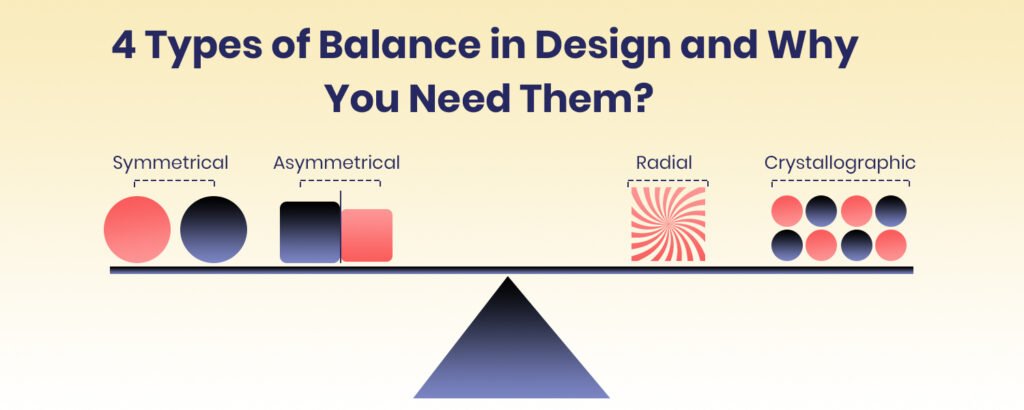
Designing is an art that narrates a story with vibrancy. Every right design runs by the rule of “Right Balance” for achieving a desirable outcome. As goes the saying, “too many cooks spoil the broth” simply means that balance is important in every aspect of life, and an excess of anything will do no good. It creates composition, cohesiveness, and an optimal balance between symmetrical, radial, and asymmetrical. Balance in design is a vital factor that creates harmony in a design with perfect equations of designing elements juxtaposed with one another. But how does balance create this effect? And how can you use it for your own designs?
This post will talk about the types of balance that are the keys to a successful design.
Table of Contents
Why is balance so important in Design?
Balance is how visual elements are arranged in order, pertaining to layout, colors, design, and other elements to evoke stability so that it appeals to the human eyes. The concept of balance was incepted during the Renaissance period. Leonardo Da Vinci is renowned for managing balance in his paintings by reflecting right proportions.
A composition feels right, appealing, and fulfilled when it has balance. To achieve the right balance in design, designers need to streamline positive, negative, large, small, contrasting, and other similar elements to produce a sum of cohesive results. This creates a compelling impact on the spectators, reflecting all objects uniquely where nothing feels odd or out of place to the eyes.
The two essential terms that you should know while talking about balance in designs are visual weight and visual direction.
Visual weight: The weight that a potential object appears to get in a design.
Visual direction: The direction in which a potential object appears to be moving.
Types of balance in design
Designs or illustrations do not have physical weight, although they need to be structured with core balance namely, symmetrical, asymmetrical, radial, or crystallographic, to bring out the best way in which they appear to the viewers.
The most commonly used balance type is the symmetrical design balance.
Symmetrical balance:
Symmetrical designs appear same from all angles and sides. They are super easy to create and spot. A symmetrically balanced design looks neat and structured without any room for flaws. Such a design is embedded with wide layouts, full-width web designs, and has no place for offbeat placements. Symmetrical designs are plausible and attract our attention because they are aligned, engaging, and maintain a visual culture that connects onlookers to the narrative. Businesses use symmetrical balance to keep viewers engaged with their brand.
Although symmetrical balance is an essential and commonly known part of the balancing art and designs, it is not the only way how designs are balanced. Other categories can be incorporated too. There’s a lot more to it that you will discover as you continue reading below.
Asymmetrical balance:
If you are able to differentiate objects, layouts, colors, shapes, and other visual elements in a design, then that is what you can call an asymmetrically balanced design. Although the layouts are different, yet there is a subtle or pseudo balance within such images. They look dynamic, and interesting, embedded with modern, energetic, and engaging colors, scale, and elements on the layout.
Distance plays a huge role in promoting the asymmetrical balance, with large and heavy elements complemented by smaller and lighter elements at a distance in creating designs. In this way, nothing stays out of sight or attention.
Radial Balance:
Radial balance is for viewers that fixate on details. This balance is used for focusing a central point on an image. It is known to be a balanced and soothing element. The layout used to create such art naturally occurs in the environment namely, the inner part of shells, water, sunlight, tree rings, and flower petals. They are magnificent in their appearance and draw viewers towards the concentric designs, creating mindfulness.
Crystallographic Balance:
This form of balance is attained by creating an equalized effect among a large number of elements. This is far from creating a symmetric effect or a concentric effect on viewers but seems to offer eye twirling visuals.
Crystallographic balance uses a manifold of elements and layouts that are scattered subtly, making objects easier to locate. These designs have pace and stand unique for juggling scales, colors, and proportion, thus making them look natural and appealing to the eyes.
Other design balance-achieving techniques to live by
Every design spells a different story that entails a specific design goal. The four main balance principles of designing have already been mentioned in a detailed fashion, although other minor factors deserve your attention as well.
Apart from the four main design balances, there are other modes of design balance that you can also use to enhance your designs.
- Color balance: Colors play a critical role in highlighting even the smallest areas with great vibrancy and brightness. They add meaning to the concept of art by making it catchy and comprehensive. Also, color psychology ideas are crucial for designers to reflect the right ethos behind the art and in turn, the brand.
- Position balance: Another great way to produce balance in a design is by placing the objects within the design in right positions. The correct positioning with necessary elements offers prominent weightage and alignment, making your design look right in all manners.
- Texture balance: Texture is another sign of a balanced design. Visual weight, the right balance of thicker and thinner lines, and the calculation of appropriate dimensions allow you to achieve the perfect design balance that is in line with the design principles.
Swearing allegiance to the design balance is one of the most important tasks if you want to produce stunning designs. The right visual appeal cannot be attained sans the right balance! From colors and sizes to right symmetry and radial balance, a design (and in turn, the marketing creative) should incorporate a detailed understanding and execution of the right balance. Strike the chord and flourish results by hiring a graphics designer in India who has mastered the core principles of graphic designing.






More Stories
Personalizing User Experiences: Implementing Azure AI Services for Recommendation Systems
Best Data Recovery Software Free for Windows (2024)
The Role of Productivity Measurement Software in 2024